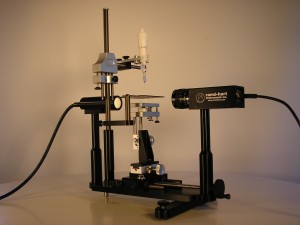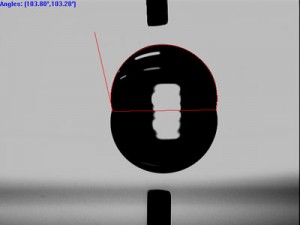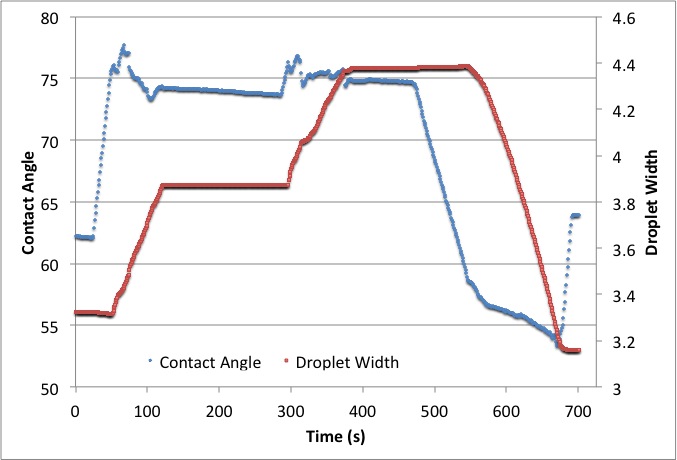Last week I learned to use a new machine – a goniometer. One of the things a goniometer does is measure the contact angle of droplets on surfaces. You can dispense some liquid out of the dropper onto a flat surface, the vision system captures data, and the software analyzes what angle is formed between the droplet and the surface.
Why is this useful? For my research, I needed to learn more about the surface properties of some materials I was interested in. If you know the contact angles of various known liquids on an unknown material, you can calculate things like the surface energy of the material. Then you can make some progress toward figuring out the work of adhesion on that surface, or the fracture energy between two surfaces.
So I thought this would be easy. Put drop on surface, measure contact angle.
But the key here is how accurate you need those measurements to be. If you only need a contact angle that is accurate to +/- 5 degrees, or even 2 degrees, the static measurement is fine. But what if you need to be more precise?
Oh, turns out that there is a whole complicated process… The ADVANCING contact angle (the angle formed as the droplet is growing) is different than the RECEEDING contact angle (as the droplet is shrinking), and both of those are different than the STATIC contact angle (droplet just sitting there). And it can be useful to know all three of those.
So an experiment typically goes like this:
Dispense droplet. Measure static angle. Add 5 microliters of fluid, and watch the angle as the droplet grows. Let it sit there as you measure the static angle again. Add another 5 microliters, watch to see if the advancing angle is the same as it was. Remove 10 microliters, and measure the receeding angle as the droplet shrinks.
The vision system captures video of this whole adding/subtracting liquid experiment, and the software spits out data about the width of the droplet and the angle as the width grows and shrinks. So an entire experiment looks like this, plotted over time:
The contact angle plotted in that chart is the average angle of the left and right side of the droplet. To find the advancing contact angle, you take the average angle over the time span where the droplet was growing. Similarly, the average of the contact angle over the time span where the width was shrinking gives you the receeding angle. And then on top of all that, the protocol is to run this experiment three times at different spots on the surface you are interested, and average all those three.
So many averages! Sometimes I do wonder how we get any data at all out of experiments… it is so difficult to be precise when making so many assumptions, estimations, and averages. And yet the data looks so pretty when reported as “The contact angle of water on a PMMA surface was 74.4 degrees.” Ah, science…
Whew. Who knew measuring droplets could be so involved?
But, I am pleased to say that my water drop on glass and acrylic measurements matched reported data in literature. Which is good, because water on glass is about the most basic thing you can do – so now I can move on to more interesting materials!





















